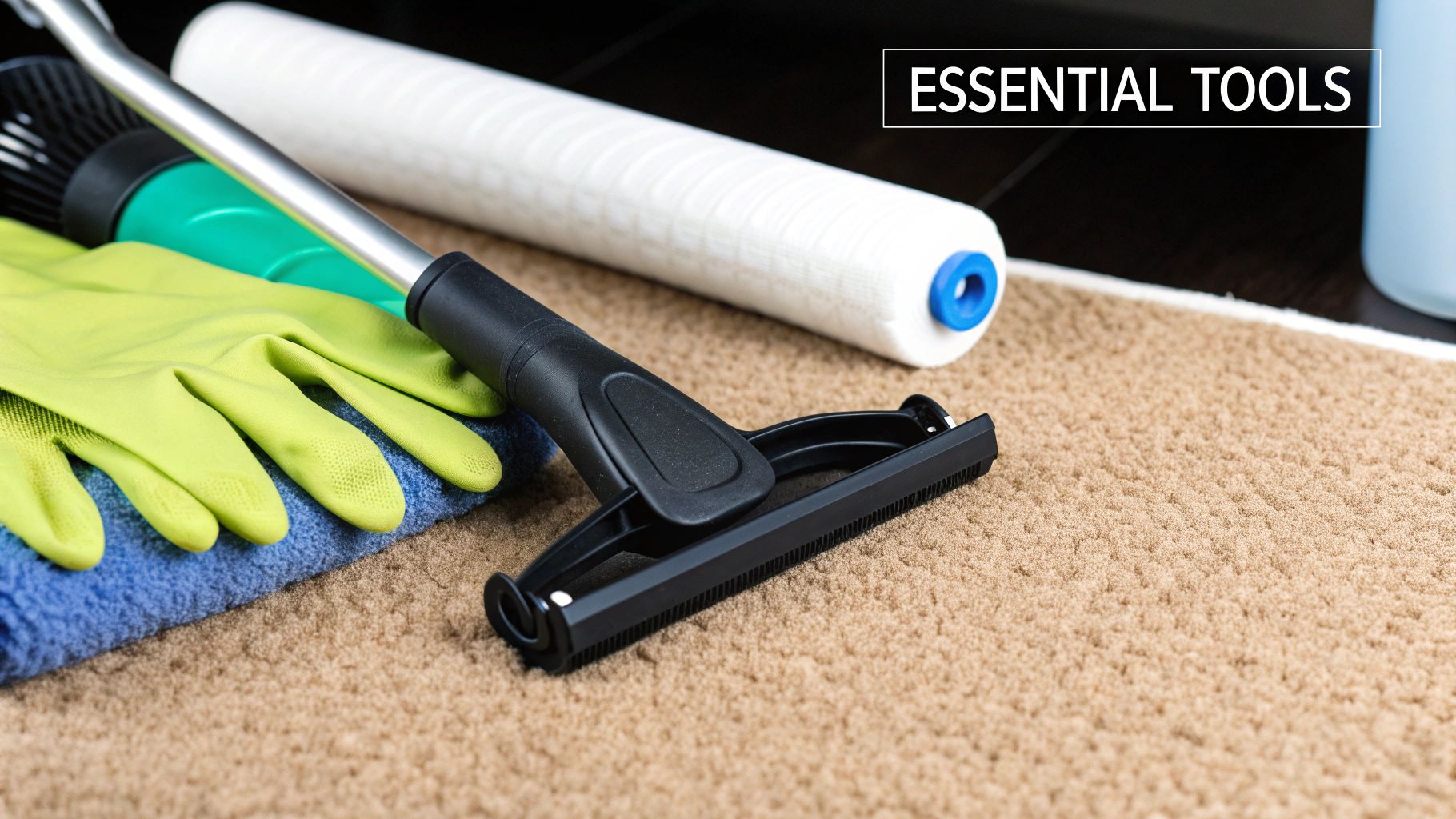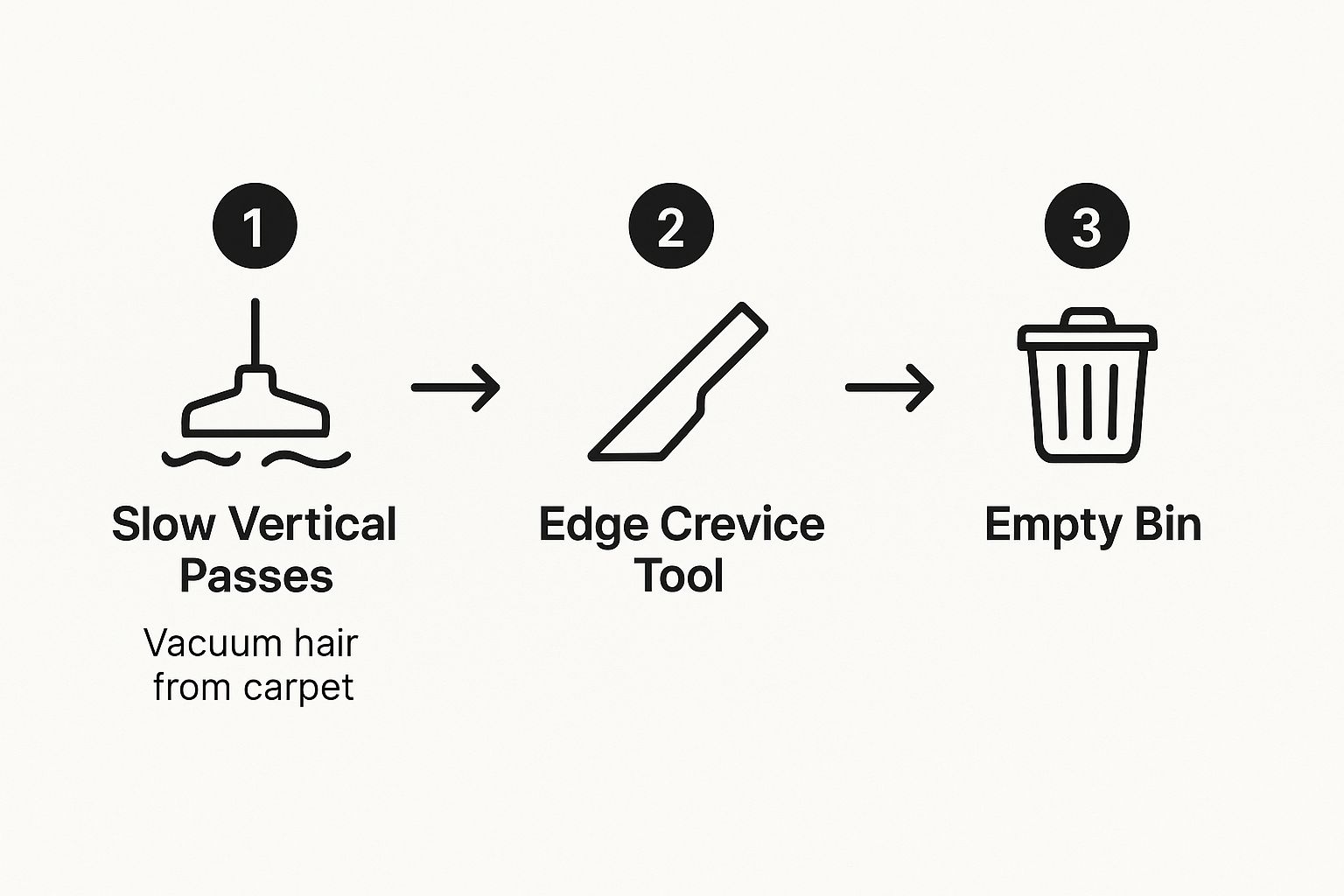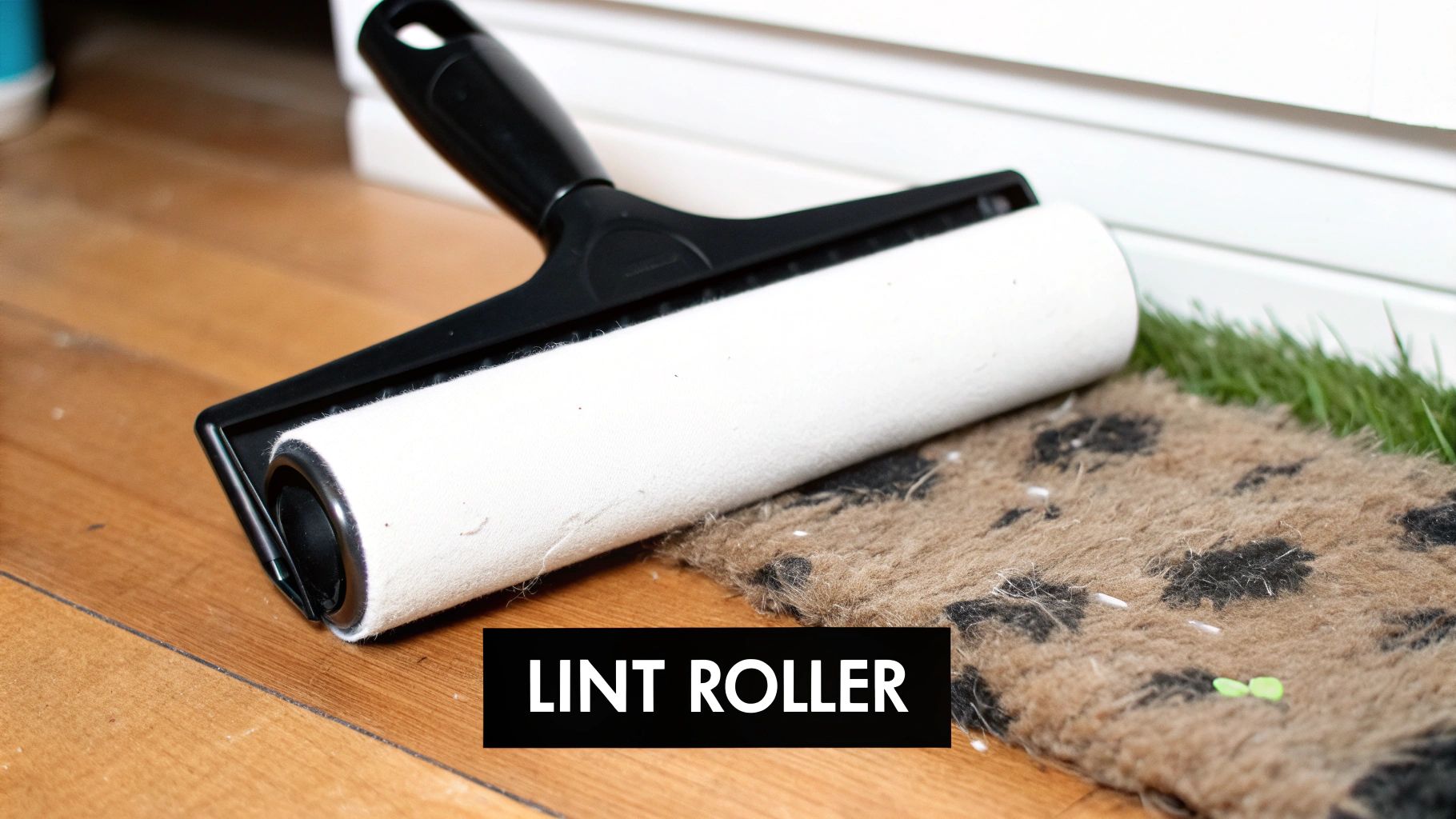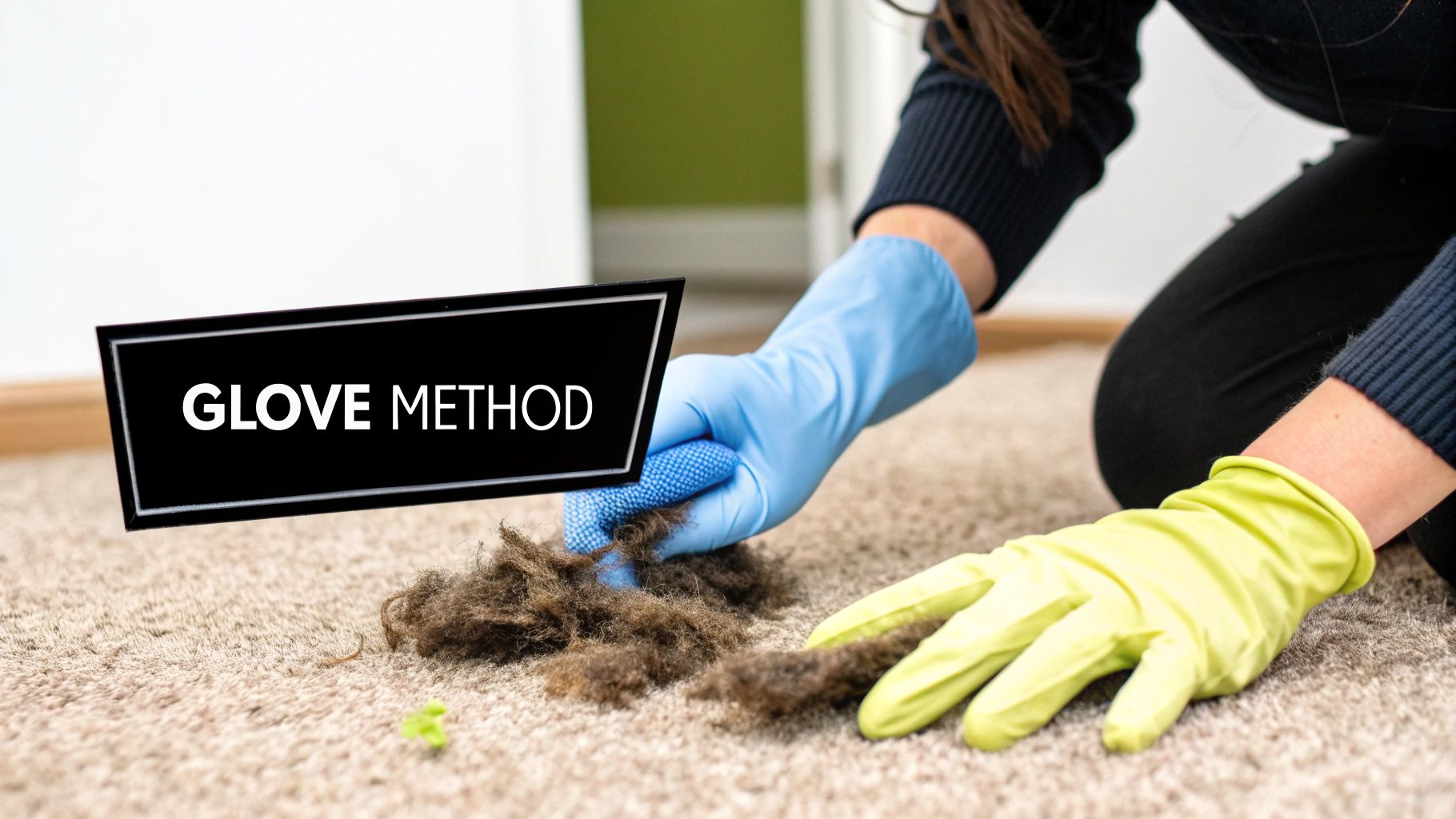Trying to get stubborn hair out of your carpet? The best approach is a simple two-part strategy. First, you need a tool to pull all that embedded hair to the surface—think a rubber squeegee, pumice stone, or even damp rubber gloves. Once the hair is loosened up, just follow up with a powerful vacuum to collect it all for a perfectly clean finish.
Your Quick Guide to a Hair-Free Carpet

Whether it's from pets or people, hair woven deep into carpet fibers is a common headache for homeowners. The good news is that the most effective solutions are often much simpler and cheaper than you’d expect. This guide will get you started with the best techniques right away.
We’re going to cover how to get hair out of your carpet using everything from basic household items to specialized vacuums. This isn't just about mindlessly running a vacuum back and forth; it's about using smart strategies that actually work.
Carpet Hair Removal Methods at a Glance
To make things easier, here’s a quick breakdown of the most popular methods. This table gives you a snapshot of what to expect from each technique in terms of effort, cost, and what it’s best suited for.
| Method | Best For | Effort Level | Cost |
|---|---|---|---|
| Rubber Squeegee | Low-pile carpets, large areas | Medium | Low |
| Pumice Stone | Tough, embedded hair in small spots | High | Low |
| Damp Rubber Gloves | Stairs, upholstery, small areas | Medium | Low |
| Carpet Rake | Deep-pile or shag carpets | Medium | Moderate |
| Fabric Softener Spray | Loosening static-bound hair | Low | Low |
| Pet Hair Vacuum | All carpet types, regular maintenance | Low | High |
Choosing the right tool depends on your carpet type and how much hair you're dealing with. A simple rubber squeegee can be a game-changer for regular maintenance, while a specialized vacuum is a must-have for homes with multiple pets.
Starting with a Quick Win
Before jumping into the heavy-duty methods, it's good to understand the basic game plan. The main goal is to first dislodge hair that has become tangled and embedded in the carpet pile. Simple tools that create friction are perfect for this first step.
After you've loosened the hair, a vacuum with strong suction and a good brush roll is crucial for the final cleanup. I always think of this as a two-stage process:
- Loosening: Manually lifting the hair from the carpet fibers.
- Collecting: Using a vacuum to suck up all the dislodged hair.
Tackling carpet hair is all about using the right tool for the job. A simple, manual tool can often outperform an average vacuum because it uses direct friction to grip and pull out what the vacuum's suction alone might miss.
It's no surprise that the cleaning industry is booming, with the global carpet cleaner market valued at USD 1.13 billion in 2023. Today's advanced machines can capture up to 90% of embedded hair by combining powerful suction with specialized brush designs. You can find more insights about the carpet cleaner market to see just how much the technology is evolving.
Simple Tools for Immediate Hair Removal
You don’t need to rush out and buy expensive gadgets to start winning the war on carpet hair. In fact, some of the most effective tools are probably sitting in your house right now, just waiting for a new purpose. These simple items use basic friction and static electricity to pull up those stubborn strands that your vacuum always seems to miss.
One of the most surprising—and satisfying—tools is a standard window squeegee. That firm rubber edge works like a magnet for hair. Just drag it across the carpet in short, firm strokes, and you'll be amazed at the clumps of hair that gather with each pass. This trick works especially well on low-pile carpets where hair doesn't have deep fibers to hide in.
A pair of damp rubber cleaning gloves can achieve a similar result. Put them on, get your palms slightly wet, and just run your hands over the carpet. The hair will cling right to the gloves. You can rinse them off and go again. This is my go-to method for stairs, upholstered furniture, and those awkward corners where bigger tools just can't fit.
Getting a Grip on Stubborn Strands
For those really tenacious, ground-in hairs, a pumice stone can be your best friend. The key here is to be gentle. Brush it lightly in one direction to avoid snagging or damaging your carpet fibers. It's perfect for those small, high-traffic spots where hair gets completely embedded. And, of course, a classic lint roller is always a great option for a quick, surface-level touch-up before guests arrive.
These manual methods are incredibly rewarding because you see the results instantly. If pet hair is your main challenge, you’ll find even more targeted tips in our complete guide on how to get rid of dog hair.
The secret to making these manual methods work is consistency. Spending just five minutes with a squeegee or rubber glove once a week can prevent the massive buildup that turns deep cleaning into a weekend-long chore.
While these tools are fantastic for loosening up all that trapped hair, you still need a solid vacuuming strategy to finish the job. This visual guide breaks down the most effective way to vacuum up every last strand you've just pulled to the surface.

As you can see, the process is all about being methodical with your passes and using the right attachments to make sure no hair gets left behind.
Get the Most Out of Your Vacuum Cleaner

Your vacuum is your number one tool in the battle against carpet hair. But just running it back and forth over the floor isn't going to cut it, especially with deeply embedded strands that have woven themselves into the fibers.
To really get hair out of your carpet, you need a smart approach. The most effective method I've found is to make slow, overlapping passes in multiple directions. It sounds simple, but it works.
First, vacuum the entire room from north to south. Then, do it all over again, this time going from east to west. Changing directions like this agitates the carpet fibers from every angle, lifting and loosening stubborn hair that a single pass would have missed.
Master Your Attachments
A standard vacuum head is great for wide-open spaces, but hair has a knack for collecting along baseboards, under furniture, and in tight corners. This is where your attachments become your secret weapon. Don't just let them sit in the closet collecting dust—put them to work!
For the main carpeted areas, stick with the motorized brush head. Its bristles are specifically designed to grab onto hair and pull it out. When you get to the edges and corners, swap it out for the crevice tool. It’s perfect for sucking up every last strand hiding along the walls.
The difference between a decent vacuuming job and a great one is all in the details. Spending just five extra minutes with the right attachments can remove a shocking amount of hidden hair, which also helps cut down on allergens in your home.
Keep Your Machine in Peak Condition
A poorly maintained vacuum just doesn't have the suction power to pull up stubborn hair. A quick check-up before you start cleaning can make a world of difference in its performance.
- Empty the Canister or Bag: Always start with an empty bin. A full vacuum has significantly less suction, leaving more hair behind on your carpet.
- Clean the Filter: A clogged filter is like trying to breathe with a stuffy nose—it chokes your vacuum's airflow. Check your manufacturer’s instructions; most filters are washable and just need a quick rinse and time to dry completely.
- Clear the Beater Bar: Hair, string, and other gunk will inevitably get tangled around the brush roll (or beater bar). Use a pair of scissors to carefully snip it all away so the brush can spin freely and do its job.
Taking a few minutes to do these simple maintenance tasks ensures your vacuum is always ready to tackle even the most persistent pet and human hair.
Picking the right vacuum can feel overwhelming, but focusing on a few key features makes all the difference for homes with pets or long-haired family members.
Vacuum Feature Checklist for Hair Removal
| Feature | Why It's Important | Recommended For |
|---|---|---|
| Strong Suction Power | Lifts deeply embedded hair and dander from thick carpet fibers. | High-pile carpets, heavy shedding pets. |
| Motorized Brush Roll | Actively agitates carpet pile to dislodge tangled hair. | All carpet types, especially plush ones. |
| Tangle-Free Technology | Prevents hair from wrapping around the beater bar, maintaining performance. | Homes with long-haired pets or people. |
| HEPA Filtration | Traps allergens, dander, and microscopic particles kicked up during vacuuming. | Allergy sufferers and pet owners. |
| Specialized Pet Tools | Crevice and upholstery tools designed to grab hair from tight spots. | Furniture, stairs, and car interiors. |
Ultimately, a vacuum with a combination of strong suction and a high-quality brush roll is your best bet for keeping carpets hair-free.
Using Sprays to Loosen Trapped Hair
Sometimes, no matter how much you scrape or vacuum, the hair just won't budge. It can get so tangled and embedded in the carpet fibers that it seems glued down. This isn't your imagination—it's usually a combination of static electricity and the natural oils or grime that bind the hair to the carpet.
This is where a simple pre-treatment spray completely changes the game. By lightly misting the carpet before you start, you can break that stubborn bond. It makes the whole removal process faster and way more effective, saving you a ton of frustration.
The DIY Static-Reducing Solution
You don't need to run out and buy a special product. One of the best tricks uses a simple mix you can whip up at home.
- Create the Mix: Just combine one part liquid fabric softener with three parts warm water in any spray bottle.
- Apply Lightly: Give the bottle a good shake and then lightly mist the hairy patches on your carpet. You're aiming for a fine mist, not a drenching.
- Let It Work: Let the solution sit for about five minutes. That’s all the time it needs for the fabric softener to neutralize the static cling.
After that short wait, you’ll find the hair is much easier to lift. Follow up with a squeegee, carpet rake, or your vacuum, and watch the hair clump together with almost no effort.
A quick spray pre-treatment acts as a release agent for stubborn hair. Think of it like using cooking spray on a pan—it prevents things from sticking, making cleanup a breeze.
Commercial Carpet Sprays
If you’d rather grab something off the shelf, there are plenty of commercial products designed for exactly this problem. The global market for carpet cleaning products was valued at a whopping USD 1.81 billion in 2023, and liquid solutions made up a dominant 30.8% of that share.
These sprays are packed with surfactants and enzymes that are pros at breaking down the oils and organic gunk trapping hair in your carpet. You can explore more details on the carpet cleaning market to see just how effective these formulas can be.
Long-Term Strategies for a Cleaner Carpet

Getting hair out of your carpet is one thing, but keeping it from piling up in the first place? That's the real secret to a home that feels consistently clean. A few proactive habits can turn hair removal from a massive chore into simple, quick maintenance.
Think of it as working smarter, not harder. Instead of letting hair build up until you're completely frustrated, small and consistent efforts stop the problem at its source. You'll never have to face that daunting deep-clean again.
Create a Proactive Cleaning Routine
Your best defense against embedded hair is a consistent cleaning schedule. Don't wait until you can see the hair weaving into the carpet fibers—by then, the job is already ten times harder.
Here are a few simple habits that will keep your carpets cleaner for much longer:
- Groom Pets Regularly: Most shedding can be stopped before the hair even touches the floor. Brushing your pets a few times a week, especially with a good de-shedding tool, will dramatically cut down on the fur that ends up in your carpet.
- Use Entryway Mats: Place high-quality mats at every door. They act as the first line of defense, grabbing hair, dirt, and whatever else is on the bottom of shoes before it gets tracked across your clean floors.
- Schedule Weekly Vacuuming: A quick, thorough vacuum once a week is non-negotiable. It stops hair from getting ground deep into the fibers, which makes every future cleaning session a breeze.
Proactive cleaning is all about creating a system that works for you. The goal isn't to spend more time cleaning, but to make the time you do spend far more effective and a lot less frustrating.
These preventative steps seriously reduce the effort you'll need for deep cleaning. By managing hair at the source, you also lower the chances of it turning into a bigger problem. For instance, when hair gets matted down with spills or dirt, you may need a more involved approach to remove stains from carpets and upholstery.
When to Call in the Pros
DIY methods are fantastic for day-to-day upkeep, but let's be honest—some jobs are just too much for a household vacuum and a bit of elbow grease. If you're staring at hair that’s been ground into the carpet for months or even years, creating those dense, matted patches, it’s probably time to call a professional.
These compacted layers of hair don't just look bad; they trap dirt, dander, and oils, making them nearly impossible to lift with standard tools. Another clear sign it's time to bring in help is when the hair buildup is causing persistent odors or making allergies worse. Hair is a magnet for allergens like pollen and dust mites, and once they're deep in the fibers, even a thorough DIY clean might not be enough to fix your home's air quality.
What a Professional Cleaner Can Do Differently
Professionals show up with the heavy-duty equipment and advanced techniques that leave consumer-grade machines in the dust. They often use a method called hot water extraction, which you might know as steam cleaning.
This isn't just about a little steam. The process injects a high-pressure mix of hot water and cleaning agents deep into the carpet pile. This blast dislodges the most stubborn, embedded hair while also sanitizing the fibers from the inside out.
When your best efforts aren't cutting it, services like professional carpet shampooing services can be a game-changer, removing deeply embedded hair and truly revitalizing your carpets.
After the deep clean, their powerful, truck-mounted vacuums get to work. They extract the water, grime, hair, and allergens with incredible force, leaving your carpet cleaner and healthier than you could ever get it on your own. There’s a reason this industry was valued at USD 55.16 billion in 2022—the results speak for themselves.
Experts claim these methods can remove upwards of 98% of embedded pollutants. If your own efforts just aren't giving you the fresh, clean carpet you want, investing in a professional service can restore its life and make your home feel brand new. You can learn more about the carpet cleaning services market to see just how much of an impact it has on household hygiene.
Common Questions About Carpet Hair Removal
Even after you've got your tools and game plan ready, a few questions always pop up when you're trying to get hair out of a carpet. Let's tackle some of the most common ones I hear, so you can clean with confidence and sidestep the usual mistakes.
How Often Should I Deep Clean for Hair?
If you have pets or anyone with long hair at home, a deep clean is way more than just a spring-cleaning task. Your weekly vacuuming is a must, but you'll want to schedule a more intensive session with a squeegee, carpet rake, or a liquid pre-treatment at least once a month.
Doing this stops the hair from weaving itself deep into the carpet fibers and becoming matted down. Consistency is everything—it transforms a huge, frustrating chore into a quick, manageable task. If you're trying to build a solid routine, our complete house cleaning schedule guide can make a huge difference.
Can These Methods Damage My Carpet?
Absolutely. Some of these methods definitely need a gentle touch. While tools like a rubber squeegee are pretty safe for most carpets, you have to be more careful with anything abrasive.
A quick pro tip: when using something like a pumice stone, always test it on a hidden spot first, like inside a closet. Use light, even strokes and only move in one direction. This will help you avoid snagging delicate fibers, which is especially important on looped Berber or pricey wool carpets.
What Is the Best Tool for High-Pile or Shag Carpets?
Oh, the dreaded shag carpet. They're notorious for trapping hair deep down where a standard vacuum just can't reach. For these fluffy carpets, a carpet rake is your absolute best friend.
A good carpet rake has long, stiff tines that can dig deep into the pile to pull up all that trapped hair, dust, and debris without yanking out the fibers. It basically "fluffs" the carpet while dislodging all the hidden gunk, which makes your follow-up vacuuming session way more effective.
At Custom Maids, we get it—sometimes the deep-seated hair and dirt feel like a losing battle. If you need a professional touch to bring your carpets back to life, we're here to help. Get a free consultation today!

